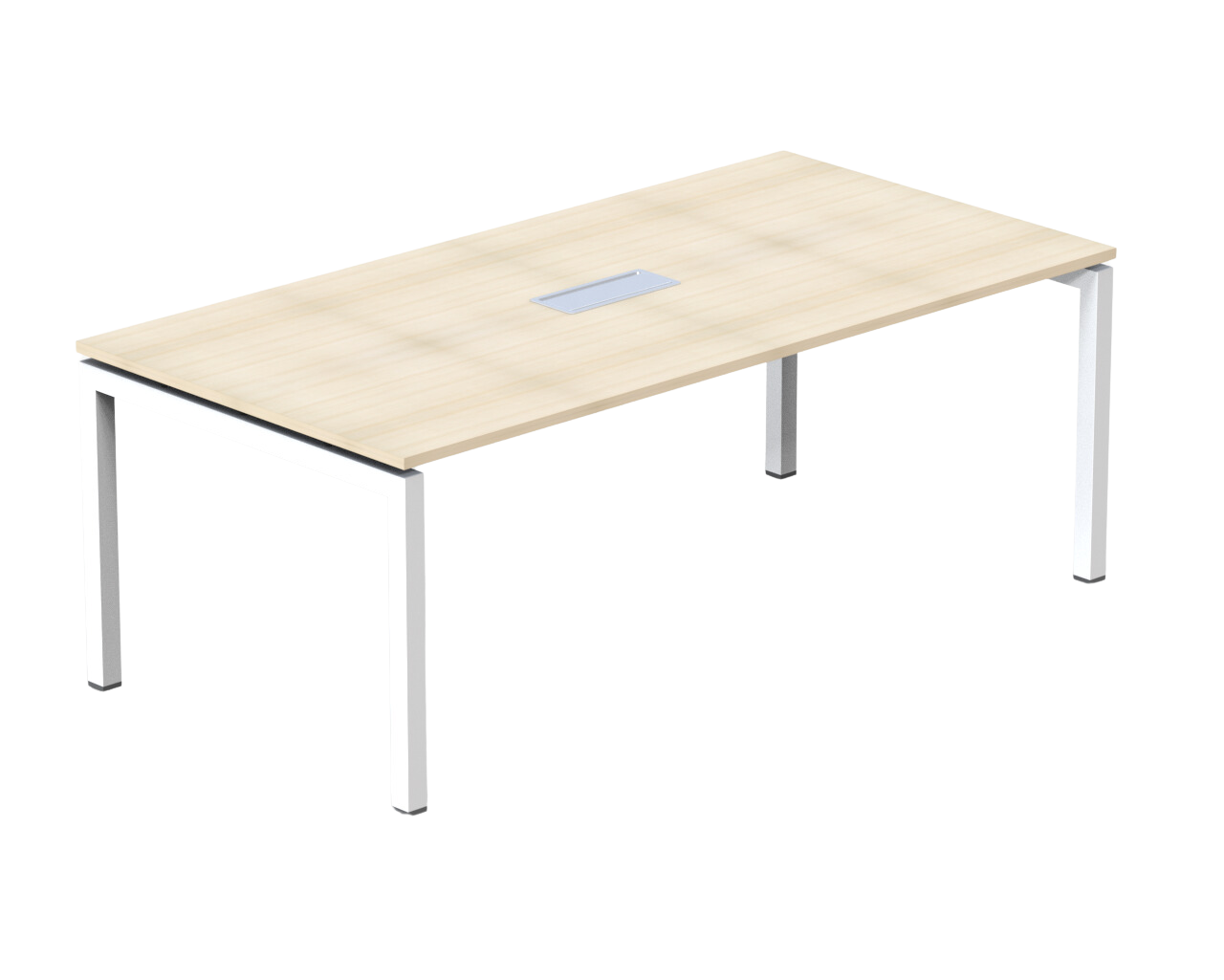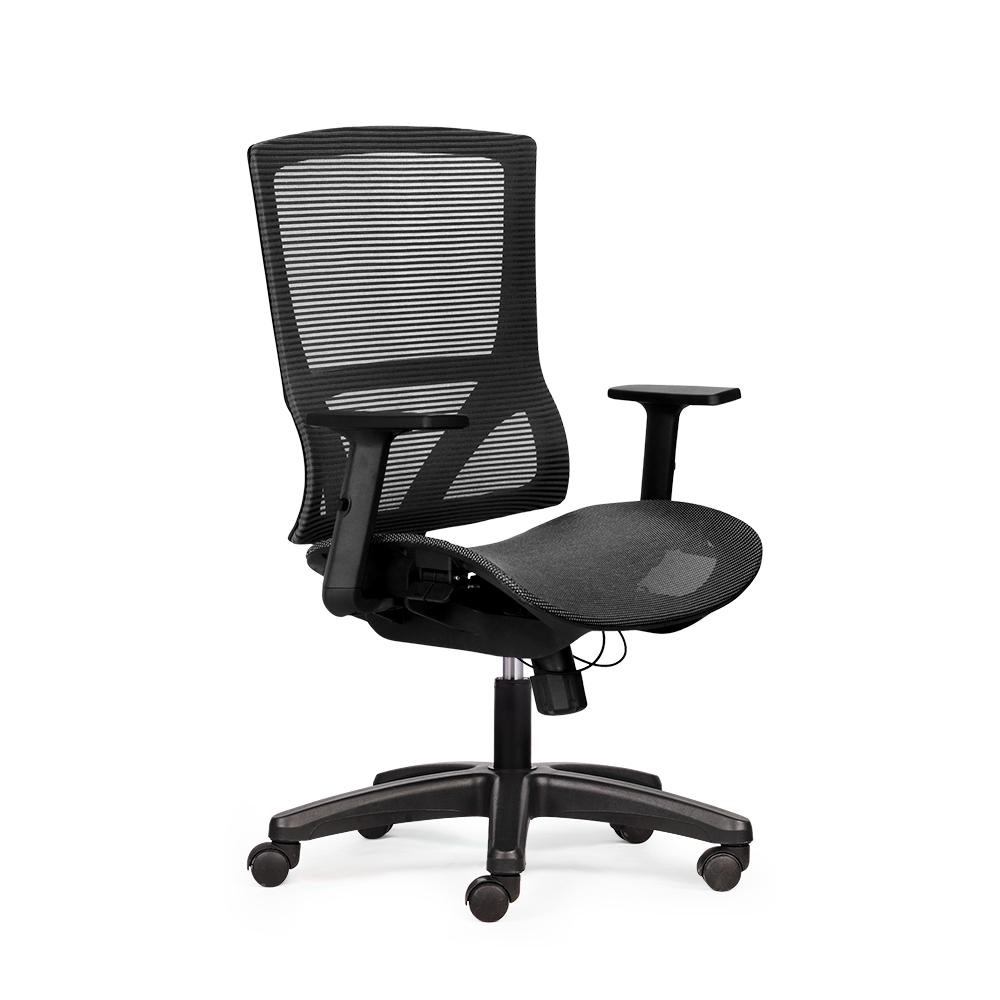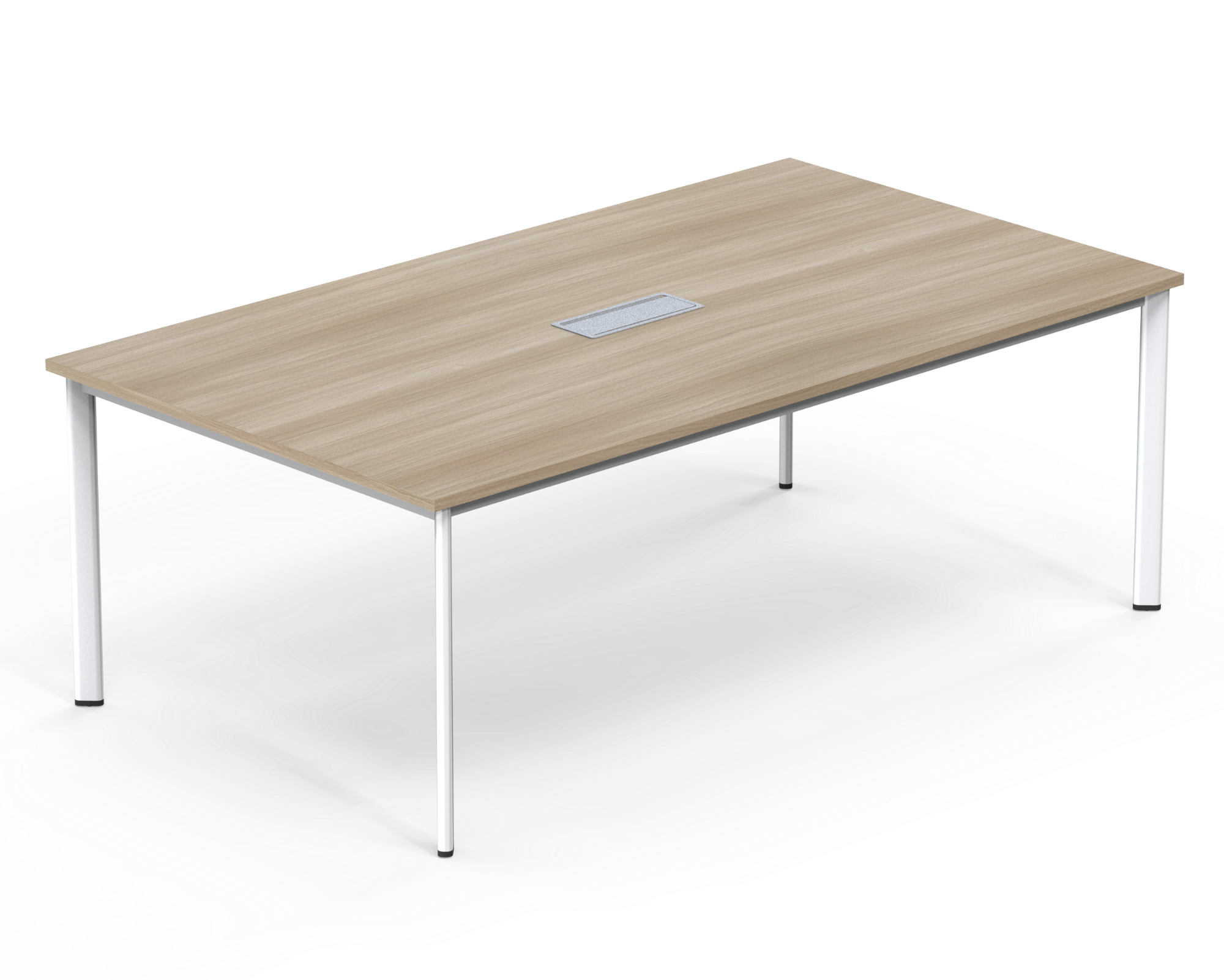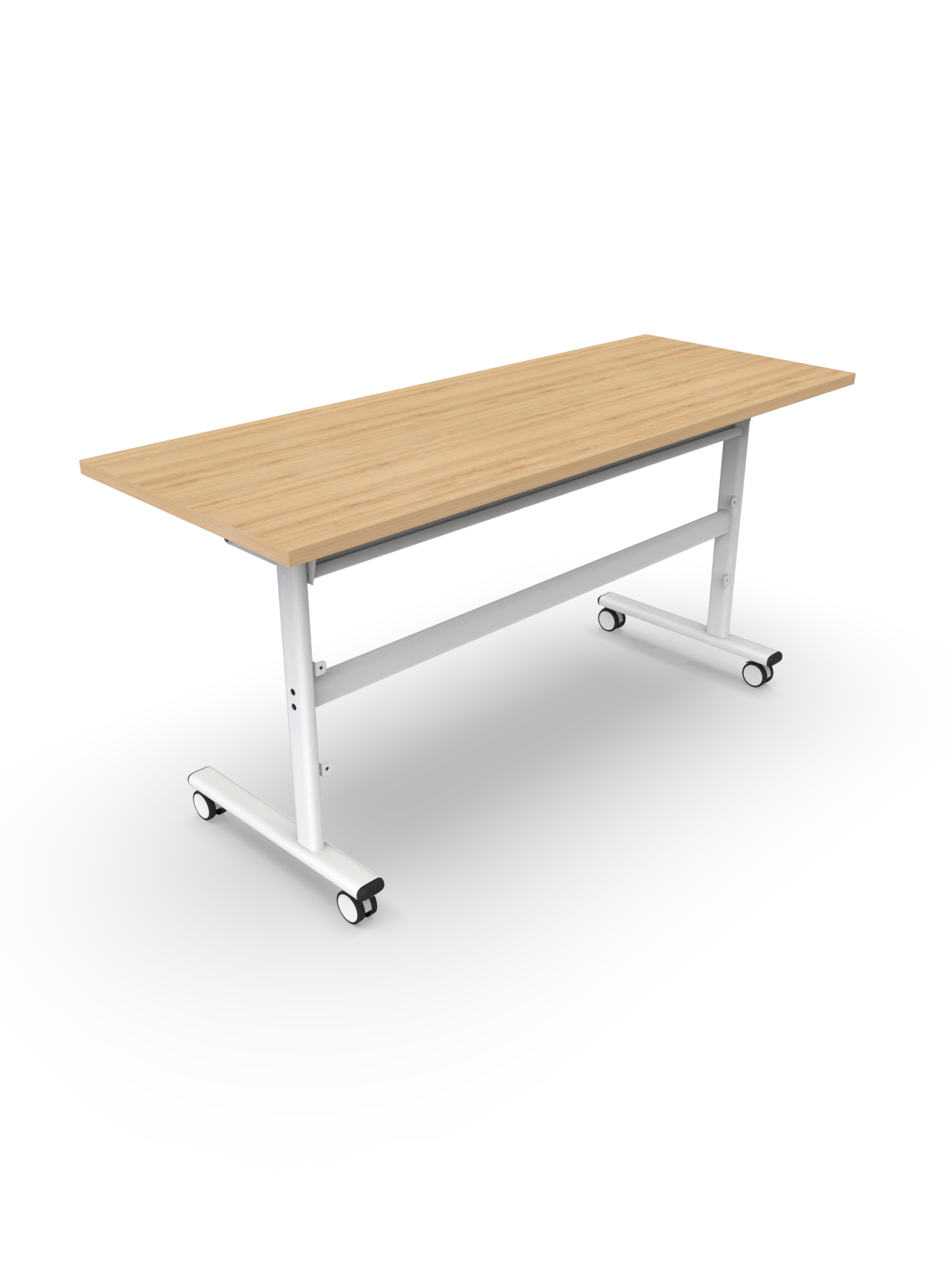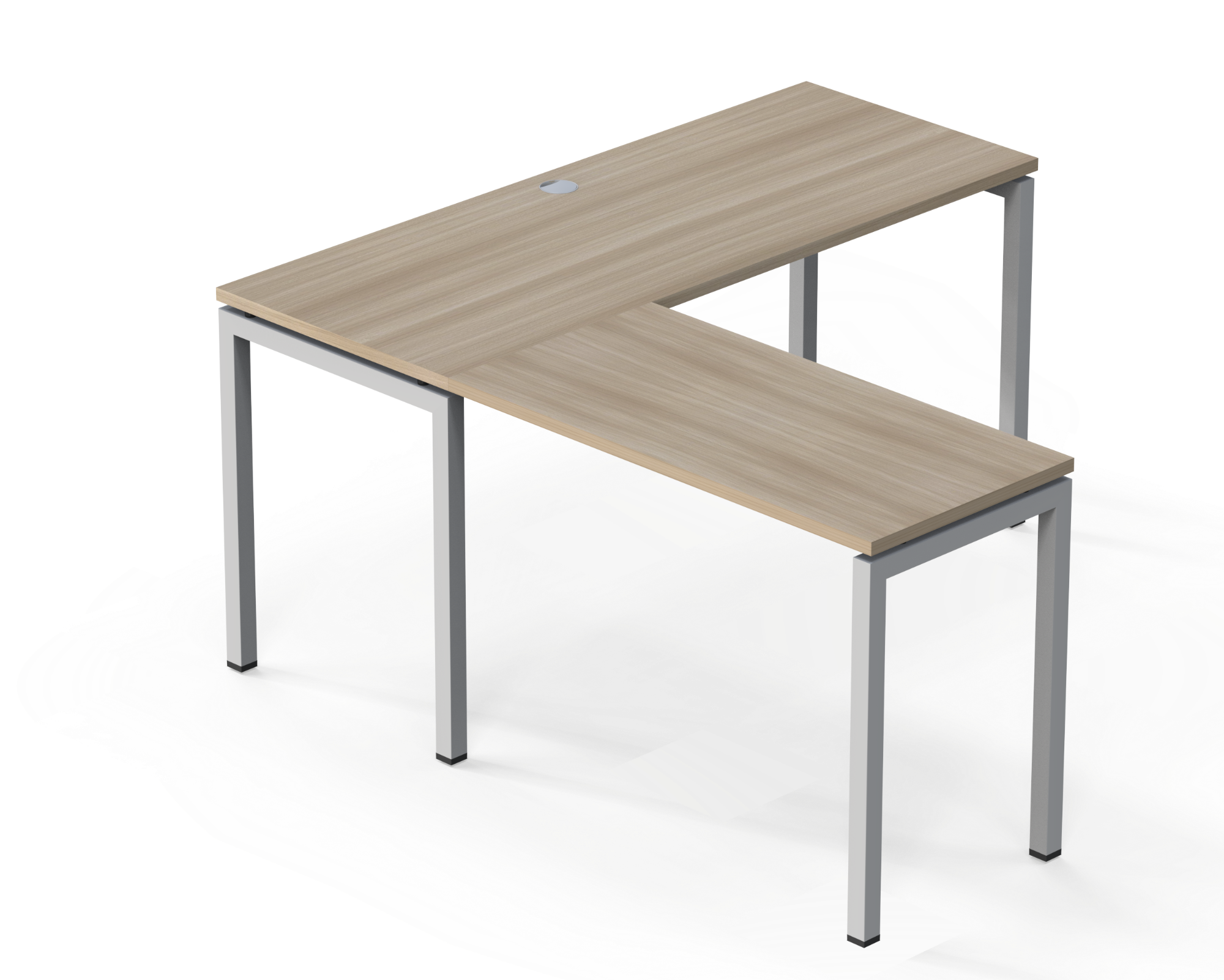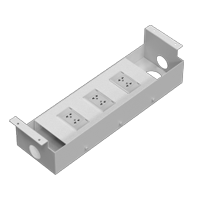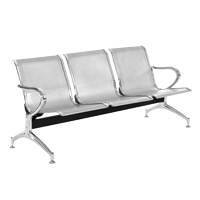
Modern Meeting Tables: Key Features and Comparison with Traditional Ones
In office spaces, a meeting table is not just where discussions and planning take place—it’s the centerpiece that fosters collaboration and enhances professionalism. Over time, meeting tables have evolved to meet the growing demands of modern businesses. So what is a modern meeting table, and how is it different from a traditional one?

1. Modern meeting tables – Definition and key features
1.1. What is a modern meeting table?
A modern meeting table is designed with minimalist aesthetics, smart functionality, and ergonomic comfort to meet the flexible needs of contemporary workspaces. Unlike traditional meeting tables that prioritize grandeur, modern tables focus on:
-
Space optimization: Compact designs that fit various room sizes.
-
Ergonomic features: Comfort for prolonged meetings.
-
Technology integration: Built-in power outlets, USB ports, and video conferencing support
1.2. Recognizing modern meeting tables
✅ Materials: Premium engineered wood combined with powder-coated metal or chrome-plated steel legs for durability and style.
✅ Designs: Variety of shapes (rectangular, oval, round) suitable for different office layouts.
✅ Colors: Neutral tones like white, black, gray, and natural wood grain for a sleek look.

2. Key differences: Modern vs. traditional meeting tables
2.1. Design comparison
-
Traditional tables: Bulky, often made of solid wood in dark tones for a formal and authoritative feel.
-
Modern tables: Sleek, lightweight designs with clean lines, ideal for dynamic office environments
2.2. Functionality
-
Traditional: Limited to basic meeting use.
-
Modern: Multi-functional with tech support for online collaboration and cable management systems
2.3. User experience
Modern tables provide:
✅ Comfort: Standardized height and spacious surfaces.
✅ Flexibility: Easy reconfiguration for various meeting types.
✅ Enhanced collaboration: Perfect for brainstorming and interactive sessions

3. Why choose modern meeting tables for your business?
3.1. Optimize workspace utilization
Modern designs maximize space efficiency, suitable for both small and large meeting rooms.
3.2. Boost corporate image
A modern meeting table enhances your professional image, impressing clients and partners during visits and meetings.
3.3. Improve productivity and teamwork
Comfortable, tech-enabled tables create an environment conducive to focus and creativity.
4. Key criteria for selecting modern meeting tables
✅ Room size: Match table dimensions to room capacity and participants.
✅ Materials: Prioritize durable engineered wood with sturdy metal legs.
✅ Features: Look for tables with built-in power and USB ports for modern meeting needs.
✅ Aesthetics: Choose sleek designs that complement office interiors.
✅ Reputable brands: Ensure quality and after-sales support.
Other news
In office spaces, a meeting table is not just where discussions and planning take place—it’s the centerpiece that fosters collaboration and enhances professionalism. Over time, meeting tables have evolved to meet the growing demands of modern businesses. So what is a modern meeting table, and how is it different from a traditional one?
1. Modern meeting tables – Definition and key features
1.1. What is a modern meeting table?
A modern meeting table is designed with minimalist aesthetics, smart functionality, and ergonomic comfort to meet the flexible needs of contemporary workspaces. Unlike traditional meeting tables that prioritize grandeur, modern tables focus on:
-
Space optimization: Compact designs that fit various room sizes.
-
Ergonomic features: Comfort for prolonged meetings.
-
Technology integration: Built-in power outlets, USB ports, and video conferencing support
1.2. Recognizing modern meeting tables
✅ Materials: Premium engineered wood combined with powder-coated metal or chrome-plated steel legs for durability and style.
✅ Designs: Variety of shapes (rectangular, oval, round) suitable for different office layouts.
✅ Colors: Neutral tones like white, black, gray, and natural wood grain for a sleek look.

2. Key differences: Modern vs. traditional meeting tables
2.1. Design comparison
-
Traditional tables: Bulky, often made of solid wood in dark tones for a formal and authoritative feel.
-
Modern tables: Sleek, lightweight designs with clean lines, ideal for dynamic office environments
2.2. Functionality
-
Traditional: Limited to basic meeting use.
-
Modern: Multi-functional with tech support for online collaboration and cable management systems
2.3. User experience
Modern tables provide:
✅ Comfort: Standardized height and spacious surfaces.
✅ Flexibility: Easy reconfiguration for various meeting types.
✅ Enhanced collaboration: Perfect for brainstorming and interactive sessions

3. Why choose modern meeting tables for your business?
3.1. Optimize workspace utilization
Modern designs maximize space efficiency, suitable for both small and large meeting rooms.
3.2. Boost corporate image
A modern meeting table enhances your professional image, impressing clients and partners during visits and meetings.
3.3. Improve productivity and teamwork
Comfortable, tech-enabled tables create an environment conducive to focus and creativity.
4. Key criteria for selecting modern meeting tables
✅ Room size: Match table dimensions to room capacity and participants.
✅ Materials: Prioritize durable engineered wood with sturdy metal legs.
✅ Features: Look for tables with built-in power and USB ports for modern meeting needs.
✅ Aesthetics: Choose sleek designs that complement office interiors.
✅ Reputable brands: Ensure quality and after-sales support.
Other news
2. Key differences: Modern vs. traditional meeting tables
2.1. Design comparison
-
Traditional tables: Bulky, often made of solid wood in dark tones for a formal and authoritative feel.
-
Modern tables: Sleek, lightweight designs with clean lines, ideal for dynamic office environments
2.2. Functionality
-
Traditional: Limited to basic meeting use.
-
Modern: Multi-functional with tech support for online collaboration and cable management systems
2.3. User experience
Modern tables provide:
✅ Comfort: Standardized height and spacious surfaces.
✅ Flexibility: Easy reconfiguration for various meeting types.
✅ Enhanced collaboration: Perfect for brainstorming and interactive sessions

3. Why choose modern meeting tables for your business?
3.1. Optimize workspace utilization
Modern designs maximize space efficiency, suitable for both small and large meeting rooms.
3.2. Boost corporate image
A modern meeting table enhances your professional image, impressing clients and partners during visits and meetings.
3.3. Improve productivity and teamwork
Comfortable, tech-enabled tables create an environment conducive to focus and creativity.
4. Key criteria for selecting modern meeting tables
✅ Room size: Match table dimensions to room capacity and participants.
✅ Materials: Prioritize durable engineered wood with sturdy metal legs.
✅ Features: Look for tables with built-in power and USB ports for modern meeting needs.
✅ Aesthetics: Choose sleek designs that complement office interiors.
✅ Reputable brands: Ensure quality and after-sales support.
Other news
2. Key differences: Modern vs. traditional meeting tables
2.1. Design comparison
-
Traditional tables: Bulky, often made of solid wood in dark tones for a formal and authoritative feel.
-
Modern tables: Sleek, lightweight designs with clean lines, ideal for dynamic office environments
2.2. Functionality
-
Traditional: Limited to basic meeting use.
-
Modern: Multi-functional with tech support for online collaboration and cable management systems
2.3. User experience
Modern tables provide:
✅ Comfort: Standardized height and spacious surfaces.
✅ Flexibility: Easy reconfiguration for various meeting types.
✅ Enhanced collaboration: Perfect for brainstorming and interactive sessions

3. Why choose modern meeting tables for your business?
3.1. Optimize workspace utilization
Modern designs maximize space efficiency, suitable for both small and large meeting rooms.
3.2. Boost corporate image
A modern meeting table enhances your professional image, impressing clients and partners during visits and meetings.
3.3. Improve productivity and teamwork
Comfortable, tech-enabled tables create an environment conducive to focus and creativity.
4. Key criteria for selecting modern meeting tables
✅ Room size: Match table dimensions to room capacity and participants.
✅ Materials: Prioritize durable engineered wood with sturdy metal legs.
✅ Features: Look for tables with built-in power and USB ports for modern meeting needs.
✅ Aesthetics: Choose sleek designs that complement office interiors.
✅ Reputable brands: Ensure quality and after-sales support.
Other news
2.1. Design comparison
-
Traditional tables: Bulky, often made of solid wood in dark tones for a formal and authoritative feel.
-
Modern tables: Sleek, lightweight designs with clean lines, ideal for dynamic office environments
2.2. Functionality
-
Traditional: Limited to basic meeting use.
-
Modern: Multi-functional with tech support for online collaboration and cable management systems
2.3. User experience
Modern tables provide:
✅ Comfort: Standardized height and spacious surfaces.
✅ Flexibility: Easy reconfiguration for various meeting types.
✅ Enhanced collaboration: Perfect for brainstorming and interactive sessions

3. Why choose modern meeting tables for your business?
3.1. Optimize workspace utilization
Modern designs maximize space efficiency, suitable for both small and large meeting rooms.
3.2. Boost corporate image
A modern meeting table enhances your professional image, impressing clients and partners during visits and meetings.
3.3. Improve productivity and teamwork
Comfortable, tech-enabled tables create an environment conducive to focus and creativity.
4. Key criteria for selecting modern meeting tables
✅ Room size: Match table dimensions to room capacity and participants.
✅ Materials: Prioritize durable engineered wood with sturdy metal legs.
✅ Features: Look for tables with built-in power and USB ports for modern meeting needs.
✅ Aesthetics: Choose sleek designs that complement office interiors.
✅ Reputable brands: Ensure quality and after-sales support.
Other news
-
Traditional tables: Bulky, often made of solid wood in dark tones for a formal and authoritative feel.
-
Modern tables: Sleek, lightweight designs with clean lines, ideal for dynamic office environments
2.2. Functionality
-
Traditional: Limited to basic meeting use.
-
Modern: Multi-functional with tech support for online collaboration and cable management systems
2.3. User experience
Modern tables provide:
✅ Comfort: Standardized height and spacious surfaces.
✅ Flexibility: Easy reconfiguration for various meeting types.
✅ Enhanced collaboration: Perfect for brainstorming and interactive sessions

3. Why choose modern meeting tables for your business?
3.1. Optimize workspace utilization
Modern designs maximize space efficiency, suitable for both small and large meeting rooms.
3.2. Boost corporate image
A modern meeting table enhances your professional image, impressing clients and partners during visits and meetings.
3.3. Improve productivity and teamwork
Comfortable, tech-enabled tables create an environment conducive to focus and creativity.
4. Key criteria for selecting modern meeting tables
✅ Room size: Match table dimensions to room capacity and participants.
✅ Materials: Prioritize durable engineered wood with sturdy metal legs.
✅ Features: Look for tables with built-in power and USB ports for modern meeting needs.
✅ Aesthetics: Choose sleek designs that complement office interiors.
✅ Reputable brands: Ensure quality and after-sales support.
Other news
-
Traditional: Limited to basic meeting use.
-
Modern: Multi-functional with tech support for online collaboration and cable management systems
2.3. User experience
Modern tables provide:
✅ Comfort: Standardized height and spacious surfaces.
✅ Flexibility: Easy reconfiguration for various meeting types.
✅ Enhanced collaboration: Perfect for brainstorming and interactive sessions

3. Why choose modern meeting tables for your business?
3.1. Optimize workspace utilization
Modern designs maximize space efficiency, suitable for both small and large meeting rooms.
3.2. Boost corporate image
A modern meeting table enhances your professional image, impressing clients and partners during visits and meetings.
3.3. Improve productivity and teamwork
Comfortable, tech-enabled tables create an environment conducive to focus and creativity.
4. Key criteria for selecting modern meeting tables
✅ Room size: Match table dimensions to room capacity and participants.
✅ Materials: Prioritize durable engineered wood with sturdy metal legs.
✅ Features: Look for tables with built-in power and USB ports for modern meeting needs.
✅ Aesthetics: Choose sleek designs that complement office interiors.
✅ Reputable brands: Ensure quality and after-sales support.
Other news
Modern tables provide:
✅ Comfort: Standardized height and spacious surfaces.
✅ Flexibility: Easy reconfiguration for various meeting types.
✅ Enhanced collaboration: Perfect for brainstorming and interactive sessions
3. Why choose modern meeting tables for your business?
3.1. Optimize workspace utilization
Modern designs maximize space efficiency, suitable for both small and large meeting rooms.
3.2. Boost corporate image
A modern meeting table enhances your professional image, impressing clients and partners during visits and meetings.
3.3. Improve productivity and teamwork
Comfortable, tech-enabled tables create an environment conducive to focus and creativity.
4. Key criteria for selecting modern meeting tables
✅ Room size: Match table dimensions to room capacity and participants.
✅ Materials: Prioritize durable engineered wood with sturdy metal legs.
✅ Features: Look for tables with built-in power and USB ports for modern meeting needs.
✅ Aesthetics: Choose sleek designs that complement office interiors.
✅ Reputable brands: Ensure quality and after-sales support.
Other news
3. Why choose modern meeting tables for your business?
3.1. Optimize workspace utilization
Modern designs maximize space efficiency, suitable for both small and large meeting rooms.
3.2. Boost corporate image
A modern meeting table enhances your professional image, impressing clients and partners during visits and meetings.
3.3. Improve productivity and teamwork
Comfortable, tech-enabled tables create an environment conducive to focus and creativity.
4. Key criteria for selecting modern meeting tables
✅ Room size: Match table dimensions to room capacity and participants.
✅ Materials: Prioritize durable engineered wood with sturdy metal legs.
✅ Features: Look for tables with built-in power and USB ports for modern meeting needs.
✅ Aesthetics: Choose sleek designs that complement office interiors.
✅ Reputable brands: Ensure quality and after-sales support.
3.1. Optimize workspace utilization
Modern designs maximize space efficiency, suitable for both small and large meeting rooms.
3.2. Boost corporate image
A modern meeting table enhances your professional image, impressing clients and partners during visits and meetings.
3.3. Improve productivity and teamwork
Comfortable, tech-enabled tables create an environment conducive to focus and creativity.
4. Key criteria for selecting modern meeting tables
✅ Room size: Match table dimensions to room capacity and participants.
✅ Materials: Prioritize durable engineered wood with sturdy metal legs.
✅ Features: Look for tables with built-in power and USB ports for modern meeting needs.
✅ Aesthetics: Choose sleek designs that complement office interiors.
✅ Reputable brands: Ensure quality and after-sales support.
Modern designs maximize space efficiency, suitable for both small and large meeting rooms.
3.2. Boost corporate image
A modern meeting table enhances your professional image, impressing clients and partners during visits and meetings.
3.3. Improve productivity and teamwork
Comfortable, tech-enabled tables create an environment conducive to focus and creativity.
4. Key criteria for selecting modern meeting tables
✅ Room size: Match table dimensions to room capacity and participants.
✅ Materials: Prioritize durable engineered wood with sturdy metal legs.
✅ Features: Look for tables with built-in power and USB ports for modern meeting needs.
✅ Aesthetics: Choose sleek designs that complement office interiors.
✅ Reputable brands: Ensure quality and after-sales support.
A modern meeting table enhances your professional image, impressing clients and partners during visits and meetings.
3.3. Improve productivity and teamwork
Comfortable, tech-enabled tables create an environment conducive to focus and creativity.
4. Key criteria for selecting modern meeting tables
✅ Room size: Match table dimensions to room capacity and participants.
✅ Materials: Prioritize durable engineered wood with sturdy metal legs.
✅ Features: Look for tables with built-in power and USB ports for modern meeting needs.
✅ Aesthetics: Choose sleek designs that complement office interiors.
✅ Reputable brands: Ensure quality and after-sales support.
Comfortable, tech-enabled tables create an environment conducive to focus and creativity.
4. Key criteria for selecting modern meeting tables
✅ Room size: Match table dimensions to room capacity and participants.
✅ Materials: Prioritize durable engineered wood with sturdy metal legs.
✅ Features: Look for tables with built-in power and USB ports for modern meeting needs.
✅ Aesthetics: Choose sleek designs that complement office interiors.
✅ Reputable brands: Ensure quality and after-sales support.
✅ Materials: Prioritize durable engineered wood with sturdy metal legs.
✅ Features: Look for tables with built-in power and USB ports for modern meeting needs.
✅ Aesthetics: Choose sleek designs that complement office interiors.
✅ Reputable brands: Ensure quality and after-sales support.
